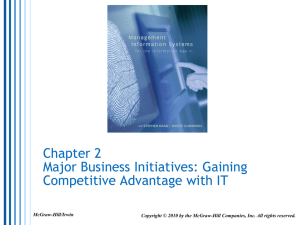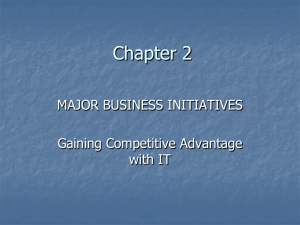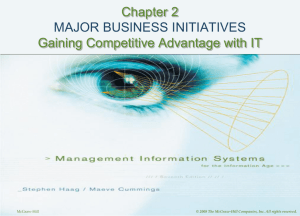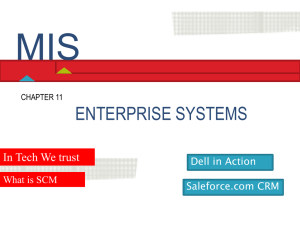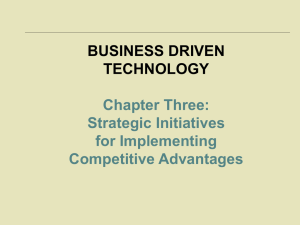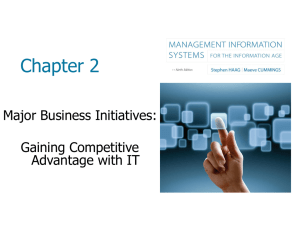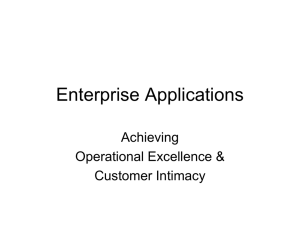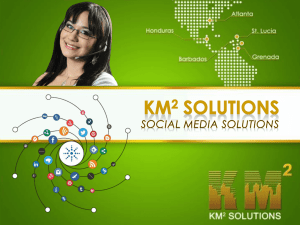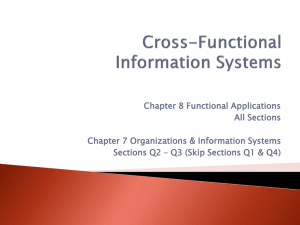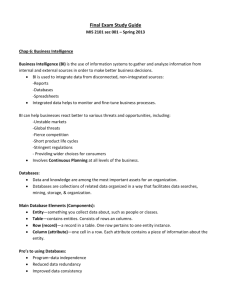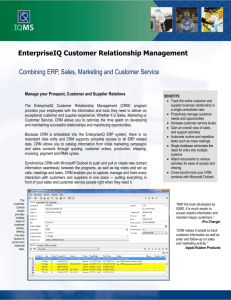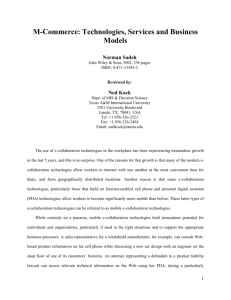Lecture slides for major business initiatives
advertisement
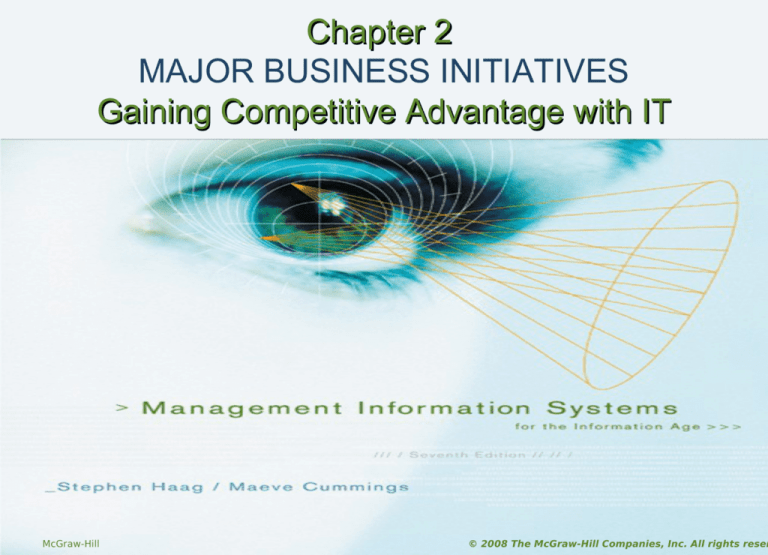
Chapter 2 MAJOR BUSINESS INITIATIVES Gaining Competitive Advantage with IT McGraw-Hill © 2008 The McGraw-Hill Companies, Inc. All rights reser STUDENT LEARNING OUTCOMES 1. 2. 3. Define supply chain management (SCM) systems and describe their strategic and competitive opportunities Define customer relationship management (CRM) systems and describe their strategic and competitive opportunities Define e-collaboration and describe its strategic and competitive opportunities 2-2 STUDENT LEARNING OUTCOMES 1. 2. Discuss the impact IT culture has on technology choices and their implementations within an organization. Explain the significance of enterprise resource planning (ERP) software as the integration of functional software systems. 2-3 CHAPTER ORGANIZATION 1. Supply Chain Management 2. Customer Relationship Management 3. Learning Outcome #3 IT Culture 5. Learning Outcome #2 E-Collaboration 4. Learning Outcome #1 Learning Outcome #4 Enterprise Resource Planning Learning Outcome #5 2-4 SUPPLY CHAIN MANAGEMENT Supply chain management (SCM) – tracks inventory and information among business processes and across companies Supply chain management (SCM) system – IT system that supports supply chain management Just-in-time (JIT) – method for producing or delivering a product or service just at the time the customer wants it Key feature of effective SCM Dell uses JIT to deliver custom computers 2-5 Dell’s Effective SCM Through JIT 2-6 Supply Chain Management Most supply chains use inter-modal transportation, multiple transportation channels (railway, truck, etc) to move products from origin destination This creates supply chain complexities 2-7 Opportunities of SCM Business strategy Overall cost leadership Bottom-line initiative Running the organization (RGT) framework Goal is to squeeze out every penny of cost possible in the supply chain This will optimize fulfillment, logistics, production, revenue and profit, and cost and price 2-8 IT Support for SCM SCM systems pioneered by specialist companies SCM is now part of ERP software (discussed later) Learn more Supply Chain Knowledge Base Supply Chain Management Review i2 Technologies CIO Magazine About Inc. Oracle/PeopleSoft Supply Chain 2-9 CUSTOMER RELATIONSHIP MANAGEMENT Customer relationship management (CRM) system – uses information about customers to gain insight into their needs, wants, and behaviors in order to serve them better Includes multi-channel service delivery, multiple ways in which customers can interact with a business Focuses on 1. 2. 3. Sales force automation Customer service and support Marketing campaign management and analysis 2-10 Customer Relationship Management 2-11 Customer Relationship Management Sales force automation (SFA) systems – automatically track all the steps in the sales process Sales lead tracking Listing potential customers Market and customer analysis Product configuration Getting repeat customers 2-12 GM’s Sales Force Automation (Purchase Funnel) 2-13 Opportunities of CRM Business strategy Differentiation and focus Top-line initiative Growing the organization Classic goals Treating customers better Understanding their needs and wants Tailoring offerings Providing “delightful” experiences 2-14 IT Support for CRM Front-office systems – primary interface to customers and sales channels Back-office systems – fulfill and support customer orders Both interface to CRM database and analysis and reporting systems 2-15 IT Support for CRM 2-16 IT Support for CRM Like, SCM systems, CRM was pioneered by specialist companies Like SCM, CRM is now part of ERP software (discussed later) Learn more Siebel Systems Salesforce.com CIO Magazine CRM Today destinationCRM.com 2-17 E-COLLABORATION E-collaboration is the use of technology to support 1. 2. 3. 4. 5. Work activities with integrated collaboration environments Knowledge management with knowledge management systems Social networking with social networking systems Learning with e-learning tools Informal collaboration to support open-source information 2-18 Integrated Collaboration Environments Integrated collaboration environment (ICE) – environment in which virtual teams do their work Virtual team – team whose members are located in varied geographical locations An ICE can be as basic as e-mail or more sophisticated as in Workflow system – automation and management of business processes (processing a loan in a bank, processing a sales order, etc) Document management system – manages a document through all stages of processing 2-19 Knowledge Management Systems Knowledge management (KM) system – IT system that supports the capturing, organizing, and dissemination of knowledge throughout the organization Knowledge of facts Sources of information Solutions, patents, and trademarks Best-practice processes 2-20 Social Networking Sites & Systems Social networking site – site on which you post information about yourself, create a network of friends, read about other people, share content such as photos and videos, and communicate with other people (e.g., Myspace, Facebook, etc) Social networking system – IT system that links you to people you know and, from there, to people your contacts know More business focused 2-21 E-Learning Tools Facilitate learning on IT-enabled platforms WebCT, Blackboard, and e-College Used in education environments and also in business environments 2-22 Informal Collaboration Previous e-collaboration tools have “organizational” focus Information collaboration tools focus on “informal” groups of people getting together Wiki – allows you – as a visitor – to create, edit, change, and often eliminate content Such content is called open-source information, content that is publicly available, free of charge, and most often updateable by anyone 2-23 Opportunities of E-Collaboration Good for just about every type of business strategy Focus, differentiation, and overall cost leadership Top line and bottom line Run, grow, and transform 2-24 IT Support for E-Collaboration Just a few of the literally hundreds of e-collaboration tools 2-25 IT CULTURE IT culture – refers to 1. 2. How the IT function is placed structurally within an organization The organization’s philosophical approach to the development, deployment, and use of IT 2-26 IT Function Structural Placement Top-down silo – IT function handles all IT needs; strong “command and control” structure 2-27 IT Function Structural Placement Matrix – Separate IT department but decision making is “matrixed” across the organization 2-28 IT Function Structural Placement Fully integrated– separate IT function but IT personnel are placed within functional areas; tremendous empowerment 2-29 IT Culture Philosophical Approach Ranging from… “Wait and see” Must prove ROI before adopting technologies Early adopters Support technology innovation failure, a reward system for trying new technologies even if they prove to be unsuccessful 2-30 IT Culture Philosophical Approach 2-31 ENTERPRISE RESOURCE PLANNING How do you bring together SCM, CRM, and ecollaboration systems? With an ERP system. Enterprise resource planning (ERP) system – collection of integrated software for business management, accounting, finance, supply chain management, inventory management, customer relationship management, e-collaboration, etc. 2-32 ENTERPRISE RESOURCE PLANNING 2-33 Major ERP Vendors 2-34 ERP Attempts to integrate everything CRM drives what SCM will produce Everyone works together in e-collaboration The entire organization knows the entire organization Think about your school Can you register for class with a bill outstanding? Can you register for a class for which you haven’t completed the prerequisite? 2-35 ERP Integrates Everything 2-36
